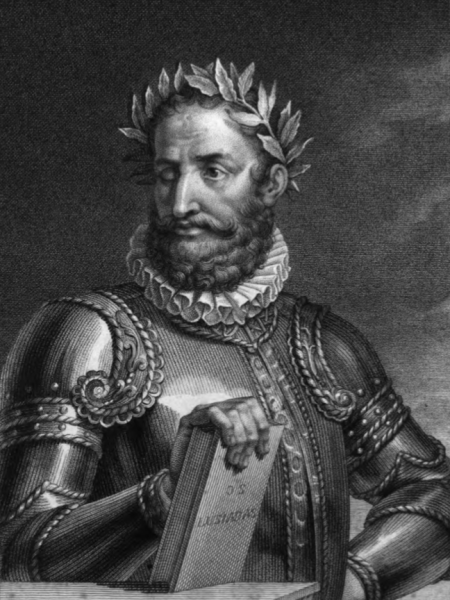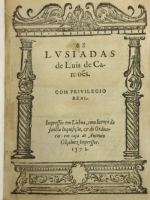
From manuscript to print: the publication of Camões’s Os Lusíadas in the sixteenth century is an ongoing research project hosted by the Faculty of Medieval and Modern Languages and funded by the British Academy and the Leverhulme Trust. Originally it focused on the first edition of Camões’s epic poem Os Lusíadas, published in 1572, and it has now grown to include the transmission of this poem in the sixteenth and seventeenth centuries as well as the history of printing in early-modern Portugal. Os Lusíadas is the Portuguese national poem and has been widely regarded as one, if not the greatest, achievement of Lusophone literature. For over four hundred years, it has invited humanists and scholars to continually study and reflect upon it.
Camões was a soldier and a poet – “Nũa mão sempre a espada e noutra a pena” – in his own words. In his youth he had access to the Portuguese court, where he may have been persona non grata. He later served in the Portuguese possessions in Africa and Asia, and was able to return to Lisbon thanks to friends who cleared his debts. A few years later, his masterpiece was published. Although Camões is known today for a wider oeuvre, including lyric poetry and drama, Os Lusíadas is almost the only text published in his lifetime. It is not known how he funded its publication, which appears to have received some appreciation at the time, although nothing compared to the prestige he would later enjoy. In fact, few years later another epic poem came out from the same press which was either more successful then or more lavishly funded. Camões died some years later, probably in extreme poverty. His fame must have rocketed in the next decades, though, as Os Lusíadas was nominally re-published three times until 1600, making it by far the most published text in Portuguese in the sixteenth century. This must have invited the posthumous publication of his lyric poetry. But such was the audience’s appetite that, from the sixteenth up to the nineteenth century, almost every subsequent edition of Camões’s works featured “new” or yet “unpublished” poems by him.
For these reasons, it is not known how many poems Camões wrote or even which poems transmitted today were written by him. Regarding Os Lusíadas, while immune to questions of authorship, its printing has afflicted human understanding with other doubts. It was remarked in the seventeenth century that there are two editions, extremely similar, bearing the same date and, nominally, issued by the same printer, António Gonçalves. Over the last two centuries, many a distinguished mind has applied itself to explain the intricate mysteries surrounding these editions. It has been posited that there are two, three and even four editions dated 1572. It has also been proposed that there is only one edition undergoing gradual textual correction. There may be at least grains of truth in all these hypotheses, but the dominant view is by far that which posits two editions, one being a later, pirate edition, pretending to be the first. Among supporters of this hypothesis, some maintained that many specific copies could be made up of sheets from both editions.

The idea of a fraudulent replica seems compelling when one focuses on their similarities. There are many obvious typos, such as upside-down characters, which seemingly occur in all known copies. The hypothesis, however, seems undermined if one focuses on their differences. The two editions have different spellings, small textual variations, typos which are specific to one or the other and two title pages which, although similar, are inverted images.
The textual variants across the copies dated 1572 have not been fully recorded. It is not known who was responsible for them, or how the books were proof-read and corrected. In order to print a pirate edition, a printer would need to gather all the materials originally available to António Gonçalves – such as type and initials – except the woodblock used for the title page. The identity of this printer and the year of this possible forgery are not known. If individual copies have sheets from both editions, then one needs to explain how two editions printed independently in time and space were mixed up. These are some of the questions which have been barely addressed or not addressed at all. Thus, when this project started, the prospect was to analyse every surviving copy in detail. However, this is in itself an obstacle, as no one knows how many copies survive in the twenty-first century nor the locations of all of them. In faith, we do not know the very basics about one of the most discussed texts in Western civilization.
The project has gradually grown so as to put the publication of Os Lusíadas into a wider context. It now seeks to document all the titles printed by António Gonçalves and to cast some light on how his workshop operated. In order to understand the size and importance of his press, the project is also looking at other sixteenth-century Portuguese printers. What was the size of a small or a productive press? Are there noticeable differences in the quality of printing undertaken by different presses? Were printing materials such as type and initials common to different printing houses or were they unique? In the same vein, in order to arrive at a better understanding of the 1572 printings, other sixteenth and seventeenth-century editions of Os Lusíadas are also being analysed. These editions have received less attention because the text transmitted by the first edition is generally believed to be closer to Camões’s original. Yet they can provide important clues about the publication of the 1572 printings and help explain how the poem was copied and transmitted over the years.
Lastly, apart from seeking answers to fundamental questions around Os Lusíadas, this project is concerned with preserving the human cultural heritage. It has given this investigator an opportunity to travel through Europe, Brazil and the USA to study and document every surviving copy of Os Lusíadas dated 1572. These objects are now benefitting not just from a trained pair of eyes, but also by the fact that they are being compared and documented in a systematic way both in descriptions and in hundreds of images. The living academic community will benefit from this, to the extent that few scholars could re-enact these procedures. But perhaps the most grateful might be future generations, if some catastrophe eventually happens. Since every exemplar is unique, the destruction or damage of any would be a sad loss. This work cannot substitute the books themselves, but it can greatly minimize possible future losses.